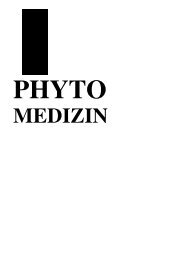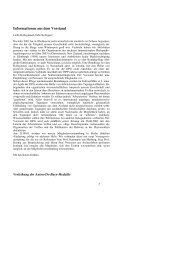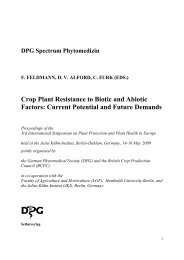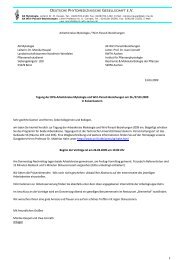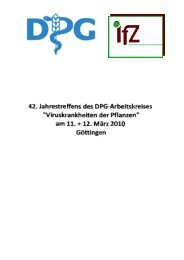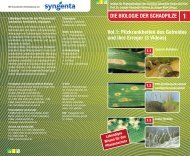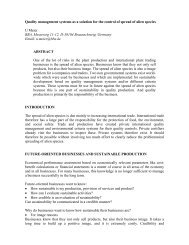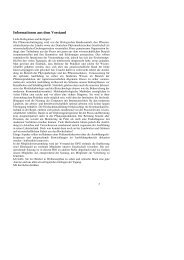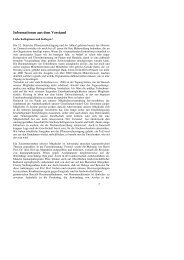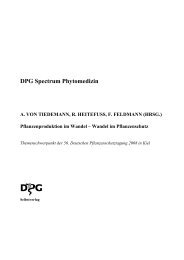PHYTO MEDIZIN Mitteilungen der Deutschen ... - Die DPG
PHYTO MEDIZIN Mitteilungen der Deutschen ... - Die DPG
PHYTO MEDIZIN Mitteilungen der Deutschen ... - Die DPG
Erfolgreiche ePaper selbst erstellen
Machen Sie aus Ihren PDF Publikationen ein blätterbares Flipbook mit unserer einzigartigen Google optimierten e-Paper Software.
conserved viral replicase–encoding regions. Ornamental Allium plants<br />
showing diffuse yellow stripes or slight mottle were investigated for virus<br />
infection. ELISA and PCR assay showed the presence of a complex of different<br />
viruses consisting of Potyviruses, Tobacco rattle virus, Tobacco necrosis<br />
virus and a novel (unknown) Potexvirus. Sequence analysis of cloned PCR<br />
amplicon obtained with the primers Potex 4 – Potex 5, showed an 83% identity<br />
with Clover yellow mosaic virus. Testing the method on primarily infected<br />
plants and dormant bulbs of different Allium cultivars has verified the<br />
robustness for application in the routine detection of potexvirus infections.<br />
Detection, performed in microtiter plates, was rapid, specific, contamination<br />
free, reproducible and semiautomated.<br />
The nucleoprotein gene of Tomato spotted wilt virus as a tag protein fusion<br />
for easy purification and enhanced production of recombinant protein<br />
in plants<br />
C Lacorte 1,2 , D Lohuis 1 , R Goldbach 1 and M Prins 1; 1 2Laboratory of Virology,<br />
Wageningen University, Binnenhaven 11, 6709 PD, Wageningen, and EMBRAPA-<br />
Recursos Genéticos e Biotecnologia, Brasília, DF<br />
Upon infection, Tomato spotted wilt virus (TSWV) forms ribonucleoprotein<br />
particles (RNPs) that consist of nucleoprotein (N) and viral RNA. These<br />
aggregates result from the homopolimerization of the N protein, and are<br />
highly stable in plant cells. These properties feature the N protein as a potentially<br />
useful novel plant-based protein fusion system. To evaluate this potential,<br />
we tested whether the N protein and N protein fusions could be<br />
efficiently produced in plants and purified as aggregates, outside the context<br />
of viral infection. To this end the N gene was fused to GFP (Green fluorescent<br />
protein), either at the amino or carboxy terminus, in a binary vector or in<br />
a Potato virus X (PVX) vector. Nicotiana benthamiana leaves were infiltrated<br />
by Agrobacterium tumefaciens transient assay (ATTA) or inoculated<br />
with a PVX viral vector. For both expression methods N and N-GFP fusion<br />
could be detected by Western blot using antisera against N or GFP. Infiltrated<br />
leaves and infected plants expressing N-GFP fusions showed intense fluorescence<br />
un<strong>der</strong> UV light. For purification, a standard method used for viral<br />
RNPs was used, consisting of two low speed centrifugation steps and one<br />
ultracentrifugation on a sucrose cushion. The presence of N and NGFP fusions<br />
after this purification was confirmed by Western blot. Purified N-GFP<br />
retained its fluorescence, indicating no major changes in protein structure due<br />
to the (mild) purification process. These results show that the homopolimerization<br />
properties of the N protein can be used as a fast and simple way to<br />
42



